On Monday, November 9, animal rights activists celebrated the light at the end of the tunnel for captive orcas as SeaWorld CEO Joel Manby announced the company’s intention to phase out theatrical killer whale shows at its California park. But while many media outlets have interpreted Manby’s statement as an eventual end to SeaWorld’s controversial orca shows, the truth behind the SeaWorld orca show “ban,” is not quite so hopeful.
In talks with the company’s investors, Manby stated that 2016 would be the final year of SeaWorld San Diego’s Shamu Stadium performances, in which captive orcas dive, jump and even beach themselves on command. But rather than ending captive orca shows altogether, the park is merely going to replace its traditional shows with a new orca experience that Manby promises will focus on the whales’ “natural environment.” The content of these new shows is as yet unclear, but one thing is certain — the change does not signify an end to the whales’ captivity, or even necessarily to their role as performers.
SeaWorld’s decision to change its orca shows is not the result of concern for the whales’ wellbeing. Instead, Manby admits that the change is in direct response to consumer criticism, and an attempt to mitigate the damage caused to the company’s reputation by the 2013 documentary Blackfish, which focused on the death of SeaWorld trainer Dawn Brancheau after an incident involving one of the company’s captive whales. The documentary and continued fallout have been the source of major problems for the company. Since its release, SeaWorld stock has lost half of its market value, with attendance figures at the San Diego park dropping by 17 percent in the past year alone.

Although SeaWorld has dismissed the allegations of mistreatment presented by Blackfish as propaganda and emotional manipulation, the company is nevertheless attempting to clean up its image in order to stay afloat. In his talks with investors, Manby mentioned refocusing on conservation in an effort to re-brand the company and win back public favor. With the need for good PR rather than the desire for improved animal wellbeing as the motivation behind the new orca shows, it is difficult to believe that the orcas’ situation will significantly improve.
Manby states that the aim of the new shows is to be more “naturalistic,” citing guests’ desire for an orca experience that showcases “the activities the whales tend to do in the wild.” He points out that orcas “jump in the wild, and splash in the wild,” hinting that these behaviors may play a role in future shows. However, the reasons for which orcas breach, spy-hop or slap their pectorals in the wild are not the same reasons for which they perform these behaviors in captivity. Replicating “wild” activities in captivity is a contradiction in terms, especially as the orcas will return after each show to the very same holding pools that they live in today.
Jared Goodman, director of animal law for welfare organization PETA, summed the situation up succinctly, comparing SeaWorld’s latest move to “no longer whipping lions in a circus act, but keeping them locked inside cages for life.”
Blackfish is not the only thorn in SeaWorld’s side, nor the only factor behind Monday’s announcement. California lawmakers have also begun putting pressure on the San Diego park to end orca captivity. In 2014, State Assemblyman Richard Bloom proposed an Orca Welfare and Safety Act in California, the goal of which was to make it illegal to “hold in captivity, or use, a wild-caught or captive-bred orca for performance or entertainment purposes” within state boundaries. In the same year, SeaWorld San Diego applied to expand its orca environment, but was told by the California Coastal Commission that construction could only proceed if the park agreed to end its captive breeding program.
Earlier this month, California congressman Adam Schiff targeted SeaWorld directly, announcing his intent to introduce legislation that would force the San Diego park to end the captivity of orcas completely. Schiff greeted Manby’s recent announcement with limited enthusiasm, pointing out that “as long as SeaWorld holds orcas in captivity, the physical and psychological problems associated with their captivity will persist.” That the announcement was made in a direct attempt to alleviate the tide of opposition currently gaining momentum in California is made obvious by the fact that the changes will not be implemented at SeaWorld’s other parks. In Texas and Florida, orcas will continue to perform as they have done for years.
In reality, the changes lauded at the beginning of the week as a great victory for captive orcas are limited at best. The motives behind them are questionable, and yet, they may be a step in the right direction. SeaWorld has proved that public opinion carries real weight, and that the efforts of campaigners and politicians dedicated to captive-orca welfare are capable of reaping tangible results. As the tide continues to turn against captive cetacean shows, fewer people will support them. As financial gain was the motivation upon which the captive orca industry was built, financial loss — not a concern for animal welfare — may well be the cause of its demise.

